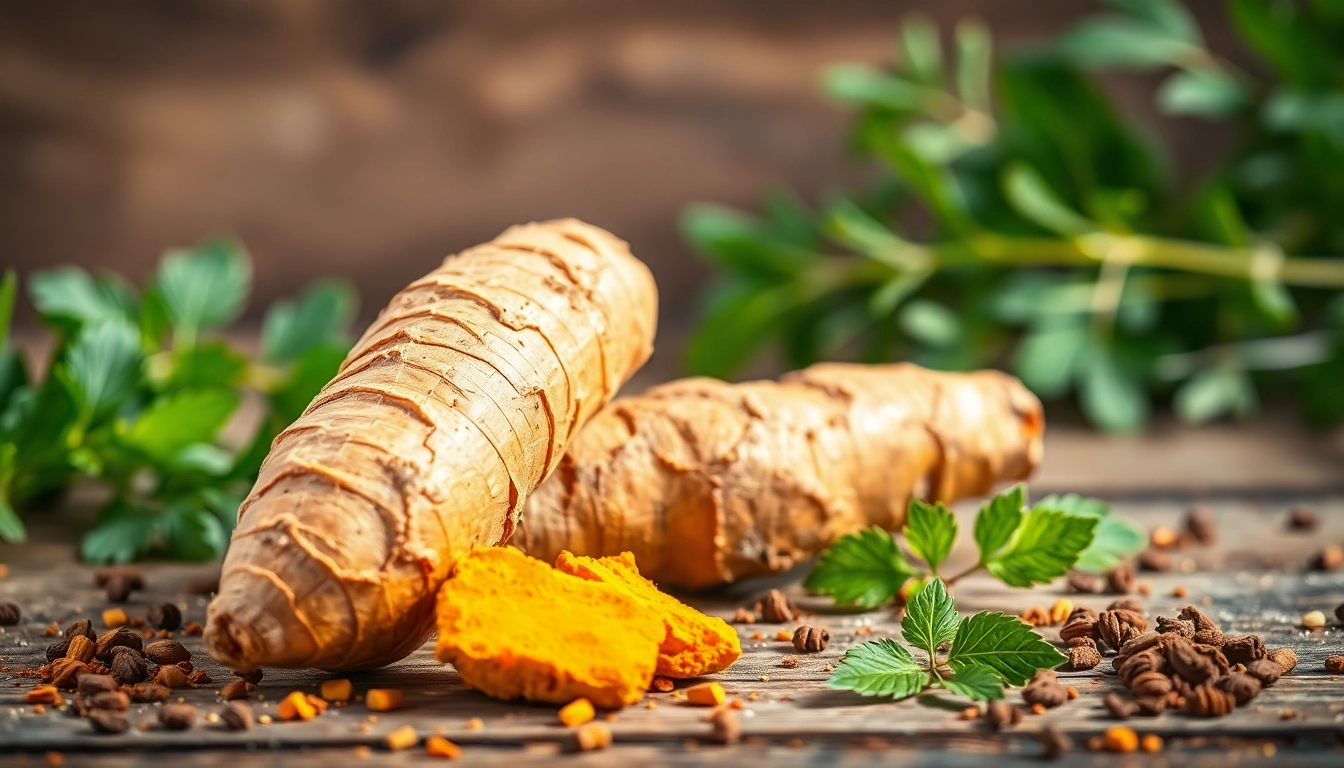Introduction to Turmeric Root
Turmeric root, a vibrant yellow spice derived from the Curcuma longa plant, is celebrated not only for its flavor but also for its extensive health benefits. Used in cooking and traditional medicine, turmeric has secured its place as a staple ingredient across various cultures. Known for its active compound, curcumin, this root has intrigued scientists and health enthusiasts alike due to its wide-ranging therapeutic properties. In this exploration, we will delve into the rich history, nutritional value, health benefits, culinary uses, medicinal practices, and the future of turmeric in wellness. For those seeking high-quality turmeric root, check out this Turmeric Root.
What is Turmeric Root?
Turmeric root is the underground stem (rhizome) of the turmeric plant, characterized by its bright orange-yellow color and earthy flavor. As a culinary spice, it is commonly used in South Asian cuisine, particularly in curries, where it not only imparts color but also depth of flavor. Turmeric has gained international fame, being incorporated into various dietary practices, including vegan and vegetarian diets, due to its robust health properties.
Historical Significance of Turmeric
The history of turmeric is rich and extensive, dating back thousands of years to ancient India, where it was utilized in culinary practices, religious ceremonies, and traditional medicine. It holds a significant place in Ayurveda, which advocates holistic healing practices that incorporate natural substances. The spice was also traded along the Spice Route, emphasizing its global importance.
Nutritional Profile of Turmeric Root
Turmeric root is not only a source of flavor and color but also a powerhouse of nutrients. A single tablespoon of turmeric provides approximately:
- 29 calories
- 0.9 grams of protein
- 0.3 grams of fat
- 6.4 grams of carbohydrates
- 1.4 grams of dietary fiber
Moreover, it is rich in vitamins, especially vitamin C, vitamin B6, and niacin, and minerals such as potassium, calcium, copper, and iron. The most notable component, curcumin, accounts for about 3% of turmeric and contributes greatly to its health benefits.
Health Benefits of Turmeric Root
Anti-inflammatory Properties
Curcumin, the active compound in turmeric, has powerful anti-inflammatory effects. Chronic inflammation is linked to numerous health conditions, such as heart disease, cancer, and Alzheimer’s disease. Studies have shown that curcumin can inhibit various molecules that play significant roles in inflammation, thus promoting a reduction in inflammation throughout the body.
Antioxidant Effects
Oxidative stress occurs when there’s an imbalance between free radicals and antioxidants in the body, leading to cell damage. Curcumin is recognized for its antioxidant properties, which help neutralize free radicals and boost the activity of the body’s own antioxidant enzymes. This action can help protect cells from damage and reduce the risk of chronic diseases.
Potential Role in Disease Prevention
The therapeutic properties of turmeric root extend beyond anti-inflammatory and antioxidant effects. Research suggests that turmeric may play a role in the prevention of various diseases, including heart disease, diabetes, and certain types of cancer. For example, its ability to modulate insulin sensitivity improves blood sugar control and supports metabolic health. Additionally, studies indicate that curcumin can inhibit the growth of cancer cells and even reduce the spread of tumors.
Incorporating Turmeric Root into Your Diet
Culinary Uses of Turmeric
Turmeric root can be used fresh, dried, or powdered, offering versatility in various cuisines. In cooking, it adds warmth, earthy notes, and vivid color to dishes. Common uses include:
- Curries and stews
- Smoothies for added nutritional value
- As a seasoning for roasted vegetables
- In rice dishes and soups
- As a natural food coloring agent
Moreover, it can be combined with black pepper, which enhances curcumin absorption in the body, maximizing its health benefits.
Turmeric in Supplements and Teas
For those looking for concentrated benefits, turmeric supplements are widely available in various forms, including capsules, extracts, and tinctures. Additionally, turmeric tea, often made from dried root or powder, provides a soothing beverage that harnesses the spice’s properties. These formats can play a pivotal role in daily wellness routines, offering convenient ways to incorporate turmeric into one’s diet.
Creative Recipes Featuring Turmeric Root
Utilizing turmeric root in recipes can be both fun and beneficial. Here are a few creative ways to enjoy this superfood:
- Golden Milk: A soothing beverage made with warm milk (dairy or plant-based), turmeric, cinnamon, ginger, and sweetener of choice.
- Turmeric Hummus: Blend chickpeas, tahini, turmeric, garlic, lemon juice, and olive oil for a nutritious dip.
- Turmeric Rice: Combine cooked rice with sautéed onions, turmeric, and peas for a colorful side dish.
- Turmeric-Infused Smoothies: Add fresh or powdered turmeric to your daily smoothies for an antioxidant boost.
Turmeric Root in Traditional Medicine
Ayurvedic Practices with Turmeric
In Ayurveda, turmeric is known as “the spice of life” and is revered for its healing properties. It is often used to treat various ailments, including digestive disorders, skin conditions, and respiratory issues. Traditionally, turmeric is combined with other herbs and spices to enhance its efficacy in restorative practices.
Comparative Analysis with Other Herbal Remedies
When compared to other herbal remedies, turmeric stands out for its multifaceted properties. For instance, while ginger also possesses anti-inflammatory effects, turmeric has a more potent impact due to higher curcumin content. Furthermore, herbs like garlic offer cardiovascular benefits, yet turmeric is unique in its dual-action of inflammation reduction and antioxidant support.
Modern Research Supporting Traditional Uses
Modern scientific studies have corroborated many traditional uses of turmeric, confirming its effectiveness in promoting health and preventing diseases. Clinical trials and in vitro studies have demonstrated curcumin’s ability to modulate various biochemical pathways involved in inflammation and disease progression. As research continues to evolve, the endorsement of turmeric in contemporary wellness practices becomes increasingly robust.
Conclusion: The Future of Turmeric Root in Wellness
Emerging Trends and Research
The growing interest in natural remedies and plant-based wellness solutions indicates a promising future for turmeric root in health and wellness. Research is ongoing into its potential benefits for mental health, cardiovascular health, and even longevity, positioning turmeric as a valuable commodity in holistic health.
Integrating Turmeric into a Holistic Lifestyle
Incorporating turmeric root into a holistic lifestyle involves more than just diet. Consider mindfulness practices like yoga or meditation, which complement the anti-inflammatory benefits of turmeric. Being conscious of diet, physical activity, and mental well-being creates a synergistic effect that maximizes overall health.
Summary of Key Takeaways
In summary, turmeric root boasts a unique blend of flavor, historical significance, and profound health benefits. Its properties as an anti-inflammatory, antioxidant, and potential disease-preventing agent make it a valuable addition to any diet. As knowledge expands and culinary innovation continues, the presence of turmeric in kitchens and health practices worldwide is sure to grow, reflecting our ongoing search for holistic wellness solutions.






